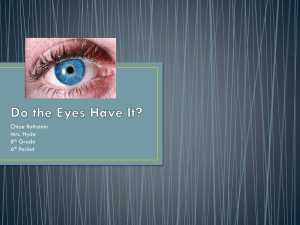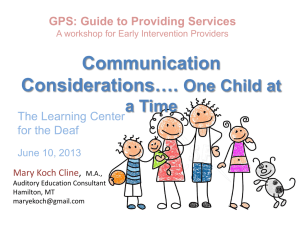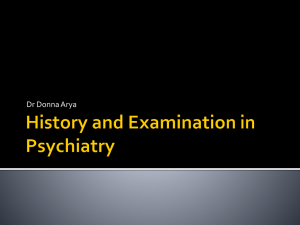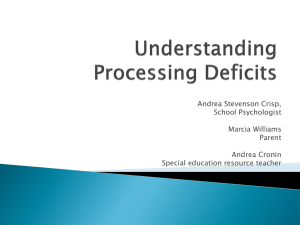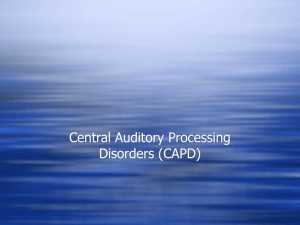Hall, Update for Aud Electrophys, Part I
advertisement
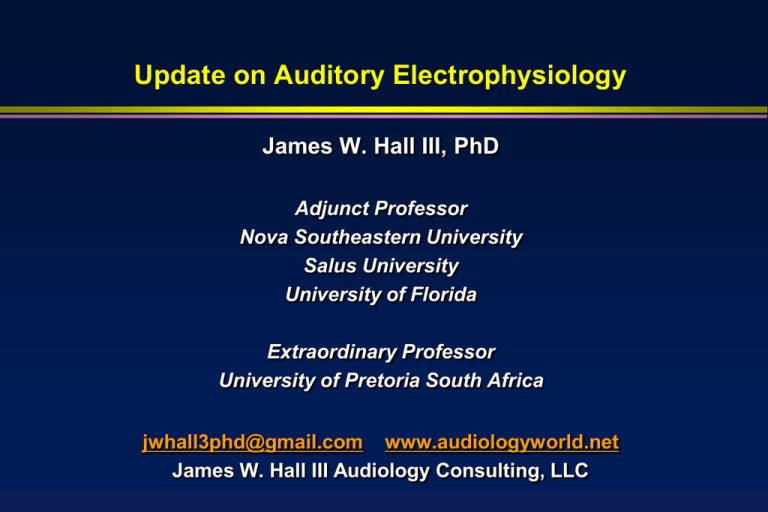
Update on Auditory Electrophysiology James W. Hall III, PhD Adjunct Professor Nova Southeastern University Salus University University of Florida Extraordinary Professor University of Pretoria South Africa jwhall3phd@gmail.com www.audiologyworld.net James W. Hall III Audiology Consulting, LLC Update on Auditory Electrophysiology Introduction to auditory electrophysiology … 85-years of research and clinical application Electrocochleography (ECochG) … It’s for much more than just the diagnosis of Meniere’s Disease ABR … Over 4000 peer-reviewed publications in the past decade alone ASSR … Filling an important niche in auditory assessment of children and adults Cortical auditory evoked responses … Now we’re really assessing hearing Summary, Questions & Answers Update on Auditory Electrophysiology: Objective Assessment from Cochlea to Cortex Cortical auditory evoked responses P300 response and other cognitive evoked responses Auditory late response (ALR) Auditory middle latency response (AMLR) Auditory steady state response (ASSR) Auditory brainstem response (ABR) Electrocochleography (ECochG) Update on Auditory Electrophysiology: Behavioral Audiometry Isn’t Always Enough Auditory electrophysiology is feasible in patients who cannot be assessed validly with behavioral techniques Newborn and older infants Difficult-to-test children Sick patients False and exaggerated hearing loss, e.g., Pseudohypacusis Functional hearing loss Non-organic hearing loss “Crocks” Update on Auditory Electrophysiology: Behavioral Audiometry Isn’t Always Enough Auditory electrophysiology is feasible in sleeping and unconscious patients Naturally sleeping children or adults Children who are sedated or anesthetized for auditory assessment Anesthetized patients undergoing surgery who require intra-operative neurophysiologic monitoring Comatose head-injured patients who require intensive care unit monitoring Automated auditory electrophysiology procedures can be performed by non-audiologic personnel for early newborn hearing screening (e.g., automated ABR) Update on Auditory Electrophysiology: Behavioral Audiometry Isn’t Always Enough (2) Auditory electrophysiology has greater sensitivity to auditory function than behavioral audiometry (e.g., ABR in early identification of retrocochlear dysfunction) Auditory electrophysiology has greater site specificity to auditory function than behavioral audiometry, e.g., ECochG differentiates sites of dysfunction in auditory neuropathy spectrum disorder (ANSD) ABR differentiates among cochlear, eighth nerve, and brainstem sites of dysfunction Cortical auditory evoked responses specify site of dysfunction with central auditory nervous system Update on Auditory Electrophysiology Introduction to auditory electrophysiology … 85-years of research and clinical application Electrocochleography (ECochG) … It’s for much more than just the diagnosis of Meniere’s Disease ABR … Over 4000 peer-reviewed publications in the past decade alone ASSR … Filling an important niche in children and adults Cortical auditory evoked responses … Now we’re really assessing hearing Summary, Questions & Answers Original Description of Electrocochleography (ECochG) Wever EG and Bray CW. 1930. Action currents in the auditory nerve in response to acoustic stimulation. Proceedings of the National Acad of Science (USA) 16: 344-350. Wever EG and Bray CW. 1930. Auditory nerve impulses. Science 71: 215. E. Glen Weaver, Ph.D. (October 16, 1902 — September 4, 1991) ELECTROCOCHLEOGRAPHY: 85 Years Old and Still Clinically Important! Ruben (CM & AP clinically) Fromm et al (CM in human) Tasaki (AP in human) Davis (SP) Yoshie, Portmann (TT CM & AP) Wever & Bray (CM in cat) 1930 1935 Coats (EAC) Coats, Eggermont, Gibson (Dx of MD) Various Hall (I/O) (ANSD, CI) 1950 1954 1960 1967 1974 1990 1996 Time in Years Electrocochleography (ECochG): Generators Cochlear microphonic (CM) Outer hair cells Receptor potentials Summating potential (SP) Inner hair cells (> 50%) Outer hair cells Organ of Corti Action potential (AP) Afferent fibers in distal 8th cranial nerve Spiral ganglion AP SP CM Electrocochleography (ECochG): Stimulus Polarity is Important ECochG Electrode Options: The Closer to the Cochlea, the Better TipTrode Trans-Tympanic Promontory Electrode TM Electrode TIPtrode: Part Transducer and Part Electrode Sub-Dermal Needle Electrode for Trans-Tympanic Promontory ECochG Recording ELECTROCOCHLEOGRAPHY (ECochG): “Traditional” Clinical Applications Estimation of auditory sensitivity in young and difficult-totest children Enhancement of wave I in ABR measurement Enhance inter-wave latency analysis in neuro-diagnosis Confirm ear-specific test findings for AC and BC ABR (wave I is a biological marker for ipsilateral 8th nerve) Minimize the need for masking of non-test ear Intra-operative neurophysiological monitoring Prompt documentation of cochlear status Enhance inter-wave latency analysis Diagnosis of Meniere’s disease “Traditional” Clinical Applications of ECochG: Enhanced Wave I and I/O Monitoring ECochG in Diagnosis of Meniere’s Disease: Abnormally Large SP/AP Ratio Coats AC (1981). The summating potential in Meniere’s and non-Meniere’s ears. Archives of Otolaryngology, 107, 199-208 ELECTROCOCHLEOGRAPHY: Selected Papers (PubMed Search on 9/9/14 at www.nlm.nih.gov with key words “Meniere’s Disease” and “electrocochleography” showed > 400 publications) Pou, Hirsch, Durrant et al. (1996). Efficacy of tympanic ECochG in the diagnosis of endolymphatic hydrops. AJO, 17 Levine, Margolis, Daly. (1998). Use of ECochG in the diagnosis of Meniere’s Disease. Laryngoscope,108 Orchik, Shea, Ge. (1998). Summating potential and action potential ratio in Meniere’s Disease before and after treatment. AJO, 19 Zack-Williams et al (2012). A comparison of ECochG and high-pass noise masking of ABR for diagnosis of Meniere’s disease. Int J Audiol, 51, 783-787 Claes et al (2013). Does “cochlear Meniere’s disease exist? An ECochG and audiometric study. Audiol Neurotol, 18, 63-70 Oh et al (2014). Can we use ECochG as a clinical tool in the diagnosis of Meniere’s disease during the early symptomatic period? Acta Otolaryngol, 134, 771-775 ELECTROCOCHLEOGRAPHY (ECochG): More Recent Clinical Applications Auditory dysfunction in tinnitus Cochlear and round window (Soundbridge) implants Round window and intra-cochlear recordings Intra-operative verification of cochlear implant function Intra-operative documentation of low frequency cochlear function during electrode insertion Prediction of speech perception outcomes Diagnosis of auditory neuropathy spectrum disorder (ANSD) Differentiation of pre- versus post-synaptic auditory dysfunction ELECTROCOCHLEOGRAPHY (ECochG): Cochlear Implant Applications Harris et al (2011). Preliminary results and technique for electrophysiological intra-operative monitoring of residual hearing during cochlear implantation. Cochlear Implants Int, 12, 209-215 Mandala et al (2012). Electrocochleography during cochlear implantation for hearing preservation. Otolaryngol Head Neck Surg, 146, 774-781 Calloway et al (2014). Intracochlear electrocochleography during cochlear implantation. Otol Neurotol, 35, 1451-7 McClellan et al (2014). Round window electrocochleography and speech perception outcomes in adult cochlear implant subjects: Comparison with audiometric and biographical information. Otol Neurotol, Epub Role of ECochG in the Diagnosis and Management of Auditory Neuropathy Spectrum Disorder (ANSD) Cerebello-pontine angle (CPA) Internal Auditory Canal (Auditory Nerve) Spiral ganglion cells IHC - 8th CN Synapse (glutamate) Inner hair cells Outer hair cells Electrococheography (ECochG): Diagnosis of Auditory Neuropathy Spectrum Disorder Guidelines for the Identification and Management of Infants and Young Children with Auditory Neuropathy (2010). Panel of Experts: Yvonne Sininger, Ph.D. Arnold Starr, M.D. Christine Petit, M.D., Ph.D. Gary Rance, Ph.D. Barbara Cone, Ph.D. Kai Uus, M.D., Ph.D. Patricia Roush, Au.D. Jon Shallop, Ph.D. Charles Berlin, Ph.D. Identification and Diagnosis of Auditory Neuropathy Spectrum Disorder (ANSD): Minimal Test Battery (2010 ANSD Guidelines) Tests of cochlear hair cell function Otoacoustic emissions (OAEs) Cochlear microphonic (ECochG and ABR) CM may be present when OAEs are absent (e.g., with middle ear dysfunction) Tests of auditory nerve function ABR for high intensity click stimulation (e.g., 80 to 90 dB nHL) with separate averages for: Rarefaction stimulus polarity Condensation stimulus polarity Additional tests Acoustic reflex measurement (generally acoustic reflexes are absent in ANSD) Suppression of otoacoustic emissions (abnormal, e.g, no suppression in ANSD) Essential Role of Electrocochleography (ECochG) in the Diagnosis and Management of Auditory Neuropathy Spectrum Disorder (ANSD): Medical diagnoses (1) Perinatal Diseases Hyperbilirubinemia Hypoxic insults Ischemic insults Prematurity Neurological Disorders Demyelinating diseases Hydrocephalus Immune disorders, e.g., Guillain-Barre sydrome Inflammatory neuropathies Severe developmental delay Essential Role of Electrocochleography (ECochG) in the Diagnosis and Management of Auditory Neuropathy Spectrum Disorder (ANSD): Medical diagnoses (2) Neuro-metabolic diseases Genetic and Hereditary Etiologies Family history Connexin mutations, e.g., GJB3 (D66del) Otoferlin (OTOF) gene Non-syndromic recessive auditory neuropathy Hereditary motor sensory neuropathies (HMSN), e.g., Charcot-Marie-Tooth syndrome Leber’s hereditary optic neuropathy Waardenburg’s syndrome Neurogenerative diseases, e.g., Friedreich’s ataxia Mitochondrial disorders, e.g., mitochondrial enzymatic defect Other Procedures Important in the Diagnosis and Management of Auditory Neuropathy Spectrum Disorder (2008 Guidelines) Components of assessment Pediatric and developmental history Otologic evaluation, plus Imaging of cochlea with CT Imaging auditory nerve with MRI Medical genetics evaluation Ophthalmologic evaluation Neurological evaluation to assess: Peripheral nerve function Cranial nerve function Communication assessment Comprehensive Assessment of Auditory Neuropathy Spectrum Disorder (ANSD): MRI of Auditory Nerve Brainstem and inner ear abnormalities in children with auditory neuropathy spectrum disorder and cochlear nerve deficiency. Huang et al. (UNC). American J Radiol, 31, 2010 • CND was identified in 33.0% of children and 26.9% of ears with ANSD • Significantly more patients with bilateral CND had intracranial abnormalities than those with unilateral CND (60.0% versus 15.8%). Unilateral auditory neuropathy caused by cochlear nerve deficiency. Liu et al (China). Int J Otolaryngol, 2012. • Cochlear nerve deficiency can be seen by electrophysiological evidence and may be a significant cause of unilateral AN. • Inclined sagittal MRI of the internal auditory canal is recommended for the diagnosis of this disorder. Auditory Neuropathy Spectrum Disorder ANSD): Defining Site of Dysfunction is the Key to Accurate Diagnosis and Effective Management Action potential (AP) Summating potential (SP) Cochlear microphonic (CM) ECochG in ANSD: Refining Diagnosis of Site of Dysfunction Santarelli, Starr, Michalewski & Arlsan (2008). Neural and receptor cochlear potentials obtained by transtympanic electrocochleography in auditory neuropathy. Clinical Neurophysiology, 119, 1028-1041. 8 subjects (with AN versus 16 normal subjects (5-48 years) Diagnosis: Presence of DPOAEs and absence of ABR Enlarged CM in AN patients Etiology Hereditary (3) Immunolological (3) Degenerative (1) Congenital (1) ECochG measures included CM SP AP ECochG in ANSD: Refining Diagnosis of Site of Dysfunction (1) McMahon, Patuzzi, Gibson & Sanli. (2008) Frequencyspecific electrocochleography indicates that presynaptic and postsynaptic mechanisms of auditory neuropathy exist. Ear & Hearing, 29, 314-325. Subjects 14 subjects (7 male and 7 female) with AN versus 2 normal subjects( Dx at 3-24 months) Diagnosis: large CM potentials and absent ABR Genetic etiology for 6 subjects Severe to profound audiometric thresholds All subjects received cochlear implants ECochG recorded with non-inverting “golf club” electrode near round window electrode via myringotomy ECochG in ANSD: Examples of ECochG Components (McMahon et al, 2008) CM Condensation Rarefaction Alternating N2 SP N1 DP (dentritic potential) Analysis Time 10 ms ECochG in ANSD: Refining Diagnosis of Site of Dysfunction (2) McMahon, Patuzzi, Gibson & Sanli. (2008) Frequencyspecific electrocochleography indicates that presynaptic and postsynaptic mechanisms of auditory neuropathy exist. Ear & Hearing, 29, 314-325. Purpose of study was to better define physiology mechanisms of AN to guide management including cochlear implantation ECochG in AN consistent with: Pre-synaptic mechanism (abnormal SP) = good EABR and CI benefit Post-synaptic mechanism (normal SP + dentritic potential) but no AP = poor or absent EABR and poor CI benefit Update on Auditory Electrophysiology Introduction to auditory electrophysiology … 85-years of research and clinical application Electrocochleography (ECochG) … It’s for much more than just the diagnosis of Meniere’s Disease ABR … Over 11,000 peer-reviewed publications with > 4000 within the past decade alone! ASSR … Filling an important niche in children and adults Cortical auditory evoked responses … Now we’re really assessing hearing Summary, Questions & Answers The First Comprehensive Description of the Auditory Brainstem Response (ABR) in Humans Jewett D and Williston J. Auditory evoked far fields averaged from the scalp of humans. Brain 4: 681-696, 1971. Don Jewett Jewett & Williston, 1971 Normal Subject Waveform Consistency … the Ideal Clinical Tool Auditory Brainstem Response (ABR): An Evidence-Based Test Protocol 0.5 uV I Stimulus Clicks Tone bursts Speech Electrodes Auditory Evoked Response System Filters Amplifiers Signal Averager III V 8 ms Generators of ABR Waves: A Far-Field Response from Sub-Cortical Auditory Pathways Generator sites I = Distal auditory nerve III = Caudal brainstem V = Lateral lemniscus Relation between anatomy and response Multiple structures contribute to single waves Waves reflect axonal activity Laterality Wave I = ipsilateral to stimulus Waves III and V = contralateral to stimulus Robert Galambos, MD, PhD Director of the Laboratory (Yale University) Where the ABR was “Discovered” and Pioneer of Early Pediatric Applications of ABR 1974: Hecox KE & Galambos R. Brain stem auditory evoked responses in human infants and adults. Archives of Otolaryngology 99. 1975: Schulman-Galambos C. & Galambos R. Brain stem evoked responses in premature infants. JSHR 18. 1979: Schulman-Galambos C. & Galambos R. Brain stem evoked response audiometry in newborn hearing screening. Archives of Otolaryngology 105: James Jerger, Ph.D. “Father of Diagnostic Audiology” Baylor College of Medicine and Methodist Hospital, Houston TX Larry Mauldin Circa 1975 Helped Build Early AER System The Cross-Check Principle in Pediatric Audiology (Jerger J & Hayes D. Arch Otolaryngol 102: 1976) The Cross-Check Principle Pediatric Audiology (Jerger J & Hayes D. Arch Otolaryngol 102: 1976) “We have found than simply observing the auditory behavior of children does not always yield an accurate description of hearing loss”… “The basic operation of this principle is that no result be accepted until it is confirmed by an independent measure.” Test Battery: • Behavioral audiometry • Immittance (impedance) measurements Tympanometry Acoustic reflexes (contralateral only with SPAR) • Brainstem-evoked response audiometry (BSER now ABR) Click stimulus air conduction Click stimulus bone conduction 1948 Vintage Audiologist Using 1980 Model Nicolet CA1000 with Infamous “Aural Dome” TDH Earphones 40 Years of Evidence-Based ABR Applications (> 11K Pubs) Since Hecox & Galambos (1974) Newborn hearing screening Diagnosis of hearing loss in infants and young children Frequency-specific estimation of auditory sensitivity Differentiation of conductive vs. sensorineural hearing loss Neuro-diagnosis of retrocochlear and brainstem disorders in children and adults Neurophysiological monitoring Intra-operative during surgical procedures Neuro-intensive care unit in head injured patients Description of neural representation of auditory processing in brainstem with speech evoked ABR Auditory Brainstem Response: The Research Continues Unabated (> 350 Publications Each Year) Descriptions of ABR applications in new clinical entities and populations Replications of traditional ABR studies in countries with emerging or rapidly growing audiology communities, e.g., India, China, Brazil, Brazil, Iran Studies of auditory processing with speech evoked ABR Investigations of new technology for ABR measurement Auditory Brainstem Response: Applications in New Clinical Entities and Populations (Plus new technology and studies in emerging audiology countries) Elkabariti et al (2014). Speech evoked auditory brainstem response findings in children with epilepsy. Int J Pedi ORL, 78, 1277-80 (Egypt) Talebi & Rezazadeh (2012). The role of ABR in diagnosing auditory impairments of Dejerine-Sottas. Int J Pedi ORL, 76, 915-917 (Iran) Jecmenica & Opancina (2014). Characteristics of brain stem auditory evoked potentials in children with hearing impairment due to infectious diseases. J Child Neurol, Epub (Serbia) Auditory Brainstem Response: Applications in New Clinical Entities and Populations Allen & Allan (2014). Auditory processing disorders: Relationship to cognitive processes and underlying neural integrity. Int J Pedi ORL, 78, 198-208 (click ABR and ARs) Hasani & Jafari (2013). Effect of infant prematurity on ABR at preschool age. Iran J ORL, 25, 107-114 (Iran) Kouni et al (2013). Brainstem auditory evoked potentials for acoustic clicks and complex verbal sounds in young adults with learning disabilities. Am J Otolaryngol, 34, 646-651 (Greece) Quevedo et al (2012). Auditory brainstem response in gas station attendants. Brazilian J ORL, 78, 63-68 Weich et al (2012). Brain stem evoked response audiometry in former drug users. Brazilian J ORL, 78, 90-96 Auditory Brainstem Response: Revisiting Old Research Topics Stevens et al (2013). ABR in newborns: Effects of electrode configuration, stimulus rate, and EEG rejection levels on test efficiency. Int J Audiol, 52, 706-712 Liu & Liu (2013). Hearing screening and diagnosis in a large sample of infants in central China. J Med Screen, 20, 21-26 (N = 11,894) Vinodh et al (2014) Reversibility of brainstem evoked response audiometry abnormalities at 3 months in term newborns with hyperbilirubinemia. Indian Pediatr, 51, 134-135 (India) Jiang & Wilkinson (2014). Impaired function of the ABR in term neonates with hyperbilirubinemia. Brain Dev, 36, 212-218 (China) Auditory Brainstem Response: Revisiting Old Research Topics Mann et al (2012). Brainstem auditory evoked responses in different phases of menstrual cycle. J Clin Diagn Res, 6, 16401643 [Do you remember? Doty RL, Hall JW III, Flickinger GL, Sondheimer SJ. Cyclical changes in olfactory and auditory sensitivity during the menstrual cycle: No attenuation by oral contraception medication. In Olfaction and Endocrine Regulation. Breipohl H (ed). London: I.R.L. Press, 1982] Rosa et al (2014). ABR: Reference-values for age. Codas, 26, 117-121 (Brazil) Naves et al (2012). Assessment of interexaminer agreement and variability in the manual classification of ABR. Biomed Eng Onine, 22, 11-16 Koors, Thacker & Coelho (2013). ABR in the diagnosis of vestibular schwannomas: A meta-analysis. Am J Otolaryngol, 34, 195-204 Auditory Brainstem Response: Innovative New Applications Ramkumar, Hall et al (2013). Tele-ABR using a satellite connection in a mobile van for newborn hearing testing. J Telemed Telecare, 19, 233-237 Auditory Brainstem Response: Speech Evoked ABR Assessment of Auditory Processing Rance et al (2012). Auditory processing deficits in individuals with open-angle glaucoma. Int J Audiol, 51, 10-15 Fujihara & Shiraishi (2014). Correlations between word intelligibility under reverberation and speech ABRs in elderly listeners. Clin Neurophysiol, Epub (Japan) Malveri et al (2014). Brainstem response to speech and nonspeech stimuli in children with learning problems. Hear Res, 313, Epub (Iran) Krisnamurti et al (2013). A case study of the changes in the speech-evoked ABR associated with auditory training in children with auditory processing disorders. Int J Pedi ORL, 77, 594-604 Auditory Brainstem Response: Speech Evoked ABR Assessment of Auditory Processing (www.brainvolts.northwestern.edu) Skoe, Krizman, Spitzer & Kraus (2013). The auditory brainstem is a barometer of rapid auditory learning. Neuroscience, 243, 104-114 Hornickel, Lin & Kraus (2013). Speech-evoked ABRs reflect familial and cognitive influences. Dev Sci, 16, 101-110 Speech-Elicited ABR: Nina Kraus at Northwestern University Auditory Neuroscience Laboratory (www.brainvolts.northwestern.edu) Fidelity to the Stimulus Amplitude Experience-Dependence Frequency (Hz) Auditory Brainstem Response: Investigations of New Technology for Measurement Neumann & Indermark (2012). Validation of a new TEOAEAABR device for newborn hearing screening. Int J Audiol, 51, 570-575 Valderrama et al (2012). Recording of ABR at high stimulation rates using randomized stimulation and averaging. JASA, 132, 3856-3865 (Spain) Muhler et al (2013). ABRs to broad-band chirps: Amplitude growth functions in sedated and anaesthetised infants. Int J Pedi ORL, 77, 49-53 : ABR Investigations of New Technology for Measurement: Chirp Stimuli Cebulla & Shehata-Dieler (2012). ABR-based newborn hearing screening with MB11 BERAphone using an optimized chirp for acoustical stimulation. Int J Pedi ORL, 76, 536-543 (N = 6866) Rodrigues et al (2013). Comparing auditory brainstem response to tone burst and narrow band CE-chirp in young infants. Int J Pedi ORL, 77, 1565-60 (Brazil) Stuart & Cobb (2014). Effect of stimulus and number of sweeps on the neonate ABR. Ear Hear, 35, 585-588 [chirp] Xu et al (2014). Prediction of frequency-specific hearing threshold using chirp ABR in infants with hearing losses. Int J Pedi ORL, 78, 812-816 Year 2007 Joint Committee on Infant Hearing (JCIH): Protocol for Evaluation for Hearing Loss In Infants from Birth to 6 months Child and family history Evaluation of risk factors for congenital hearing loss Parental report of infant’s responses to sound “Clinical observation of infant’s auditory behavior. Behavioral observation alone is not adequate for determining whether hearing loss is present in this age group, and is not adequate for the fitting of amplification devices.” Audiological assessment Auditory brainstem response (ABR) Click-evoked ABR with rarefaction and condensation single-polarity stimulation if there are risk factors for auditory neuropathy Frequency-specific ABR with air-conduction tone bursts Bone-conduction stimulation (as indicated) Otoacoustic emissions (distortion product or transient OAEs) Tympanometry with 1000 Hz probe tone Supplemental procedures, e.g., Electrocochleography (ECochG) Auditory steady state response (ASSR) Acoustic reflex measurement (for 1000 Hz probe tone)


